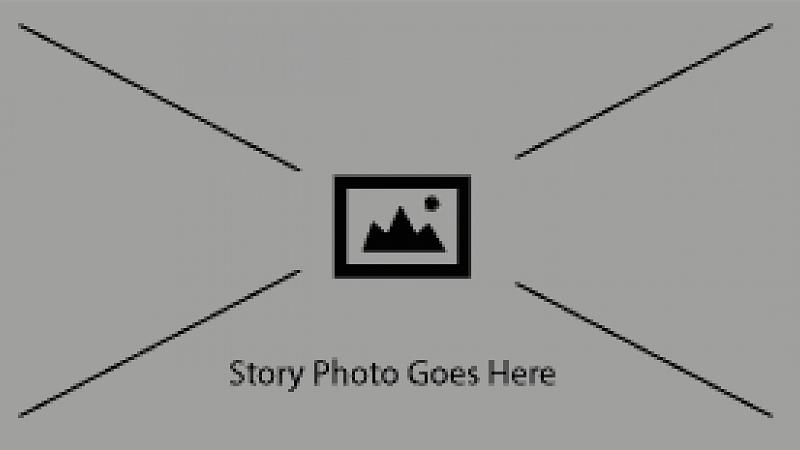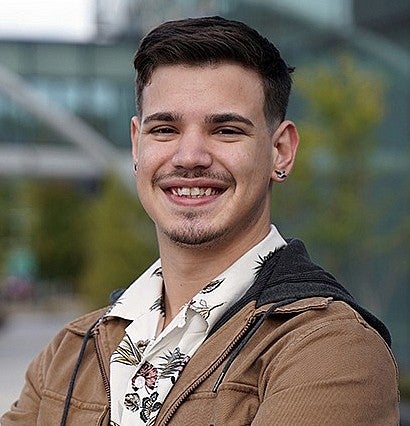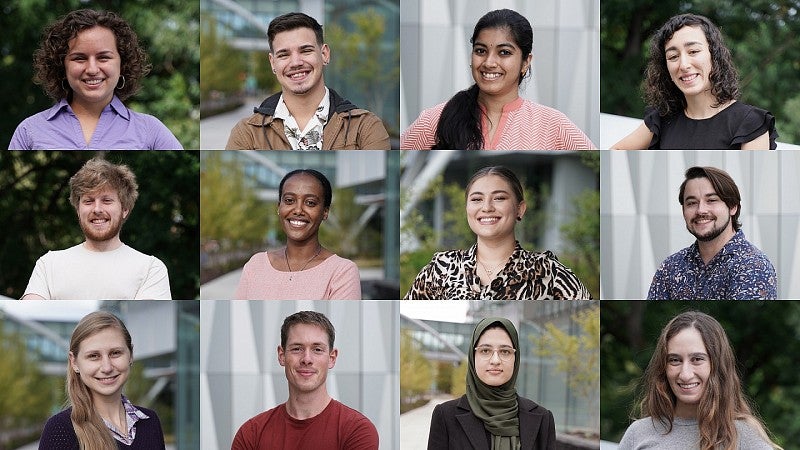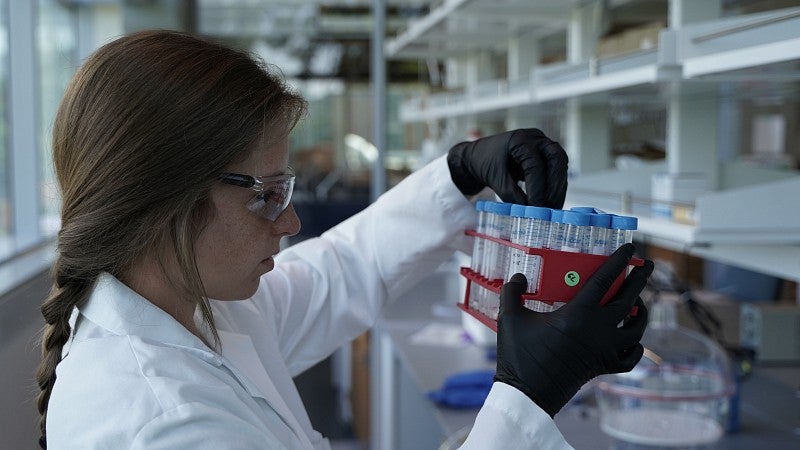

It’s been a very busy few months for Yan Carlos Pacheco, one of 12 first-year students in the Phil and Penny Knight Campus for Accelerating Scientific Impact’s Bioengineering PhD program and the first Knight Campus student recipient of a prestigious Graduate Research Fellowship Program (GRFP) award from the National Science Foundation.
Affiliated with both the Hettiaratchi and the Willett labs, Pacheco is studying inflammation due to bone defects with an eye toward promoting better healing. Pacheco’s GRFP is considered the gold standard in graduate research fellowships and is only handed out to about 2,000 students nationwide. The program recognizes and provides three years of support for outstanding graduate students who are pursuing full-time research-based master's and doctoral degrees in science, technology, engineering, and mathematics (STEM).

Additionally, Pacheco received the Promising Scholar Award from the UO Division of Graduate Studies, which helps recruit highly qualified incoming graduate students from diverse backgrounds who add to the academic and scholarly excellence of the university. A Cuba native who grew up in Florida, Pacheco organized a successful October Latin X Hispanic Celebration that drew dozens of students from across the UO to the Knight Campus Terrace for an evening of food, drinks and dancing. We caught up with Pacheco in between classes, research and the occasional social event and asked about some of his experiences at the Knight Campus.
Congratulations on your NSF Graduate Research Foundation Program award. How did that feel to receive the news?
It felt unreal and as if I was still dreaming. I remember my graduate student mentor, Jacob Griffith, had called me asking if I had seen his latest email but after not seeing anything, he told me to check the spam folder and that’s where it was! The official acceptance that I had been awarded the fellowship and I was speechless. We worked so hard together and I always find it funny that he found out before I did.
What is your area of research expertise?
In my time at Knight Campus, I want to better understand the early stages of inflammation following traumatic bone injuries. I want to combine different protein delivery technologies that Marian’s lab is developing. With temporally controlled protein delivery, I hope to be able to develop targeted exercise regimes that will not only speed up healing but result in better healing overall.
You were born in Cuba and raised in Miami. What was your childhood like and how did you get into bioengineering?
As a little kid growing up poor in Cuba, we never had money to spend on toys which naturally led me to find alternatives. I would often repurpose broken toys or fix them for the local neighborhood kids. While I always considered myself a tinkerer at heart, I thought that I wanted to become a doctor to help people but somewhere along the way, I discovered bioengineering. I was never really taught about my options in high school but after leaving Miami to attend Santa Fe Community College in Gainesville, Florida, I met my biggest advocate, (humanities professor and honors college coordinator) Bobby Hom. With his guidance, I joined (a bridge program between the community college and the University of Florida) where I started research for the first time and got paid for it. As I progressed through higher ed and eventually enrolled at the University of Florida, I realized biomedical engineering was the perfect mesh of tinkering and helping people.
What drew you to the Knight Campus?
The idea that (the campus) can become anything we put our minds to. Being that the Knight Campus is rather new, it’s a blank slate in which I get to come in and set a positive culture. The administration is very keen on student involvement, and I really enjoy the people I’m constantly surrounded by. I was also very drawn by the open concept research areas that foster collaborations. As somebody who was also involved in a lot of organizations prior to the Knight Campus, it was also exciting to think I could form these with fresh ideas and insight.
You seem to be thriving at the Knight Campus. What’s your experience been like here?
I think I’m (doing well) because of the people that I work with and constantly interact with. I really have enjoyed the relaxed nature of professors and social aspect that has come with working here. We have had so many different gatherings on the patio in which we just converse and talk about our experiences and sciences. These conversations really have helped to break down barriers between graduate students and professors such that having them accessible has really helped my understanding of research and classes. I also have enjoyed the diverse population of students I constantly work with. From my Cuban lab member to the international students from Switzerland, Iran, and everywhere else, it’s always interesting to take a step back from research and talk about how this new environment is treating us.
How did you get into bioengineering?
Almost by chance. After having trouble with my application waiver to University of Florida, I realized that there was an alternative path if I went to Santa Fe Community College instead. I distinctly remember an intro to research class where (biomedical engineering professor) Kyle Allen came, gave his speech, and suddenly, I was hooked. (He) became my research mentor for the next four years and somebody who has helped me on my journey. Having the opportunity to work at a research lab while getting paid instead of volunteering enabled me to pursue my passion for tinkering in the lab and (dedicate) a decent chunk of my time to it. It ultimately became a field where I always kept exploring new ideas and contributing to the lab.
What are your career ambitions?
That’s an interesting question that I think the answer is always evolving. Ultimately, I really want to be in a career that empowers unrepresented minorities and students to succeed in research. After attending NextProf Pathfinder (a workshop to prepare students for successful careers in academia), I believe that my passion lies in becoming a professor such that I can “tinker” with my own lab but also have a profound impact on students through mentoring and research such that the impact permeates throughout society.
Your story is an inspiring one. What lessons can you offer to other young aspiring bioengineers?
I think the biggest lesson I can offer is that if one path is inaccessible, find an alternative path to the same finish line, even if you pave that path yourself. I never had a lot of money growing up or any sort of idea of what research was, but I kept following my instincts of “hey, this is cool I’m going to follow it and see what happens.” Another big thing is to not let rejection (make you) feel like the path might not be for you. Often, I have turned rejection into ideas for alternative paths to (my) goal and as fuel for pushing forward.


